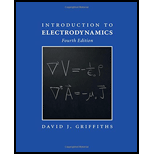
Introduction to Electrodynamics
4th Edition
ISBN: 9781108420419
Author: David J. Griffiths
Publisher: Cambridge University Press
expand_more
expand_more
format_list_bulleted
Question
Chapter 1.1, Problem 1.3P
To determine
The angle between the two body diagonals of a cube.
Expert Solution & Answer
Want to see the full answer?
Check out a sample textbook solution
Students have asked these similar questions
Hi! I need help with these calculations for part i and part k for a physics Diffraction Lab. We used a slit width 0.4 mm to measure our pattern.
Examine the data and % error values in Data Table 3 where the angular displacement of the simple pendulum decreased but the mass of the pendulum bob and the length of the pendulum remained constant. Describe whether or not your data shows that the period of the pendulum depends on the angular displacement of the pendulum bob, to within a reasonable percent error.
In addition to the anyalysis of the graph, show mathematically that the slope of that line is 2π/√g . Using the slope of your line calculate the value of g and compare it to 9.8.
Chapter 1 Solutions
Introduction to Electrodynamics
Ch. 1.1 - Using the definitions in Eqs. 1.1 and 1.4, and...Ch. 1.1 - Prob. 1.2PCh. 1.1 - Prob. 1.3PCh. 1.1 - Prob. 1.4PCh. 1.1 - Prob. 1.5PCh. 1.1 - Prob. 1.6PCh. 1.1 - Prob. 1.7PCh. 1.1 - Prob. 1.8PCh. 1.1 - Prob. 1.9PCh. 1.1 - Prob. 1.10P
Ch. 1.2 - Prob. 1.11PCh. 1.2 - The height of a certain hill (in feet) is given by...Ch. 1.2 - Prob. 1.13PCh. 1.2 - Prob. 1.14PCh. 1.2 - Prob. 1.15PCh. 1.2 - Prob. 1.16PCh. 1.2 - Prob. 1.17PCh. 1.2 - Prob. 1.18PCh. 1.2 - Prob. 1.19PCh. 1.2 - Prob. 1.20PCh. 1.2 - Prob. 1.21PCh. 1.2 - Prob. 1.22PCh. 1.2 - Prob. 1.23PCh. 1.2 - Prob. 1.24PCh. 1.2 - Prob. 1.25PCh. 1.2 - Prob. 1.26PCh. 1.2 - Prob. 1.27PCh. 1.2 - Prob. 1.28PCh. 1.3 - Prob. 1.29PCh. 1.3 - Prob. 1.30PCh. 1.3 - Prob. 1.31PCh. 1.3 - Prob. 1.32PCh. 1.3 - Prob. 1.33PCh. 1.3 - Prob. 1.34PCh. 1.3 - Prob. 1.35PCh. 1.3 - Prob. 1.36PCh. 1.4 - Prob. 1.37PCh. 1.4 - Express the unit vectors in terms of (that is,...Ch. 1.4 - Prob. 1.39PCh. 1.4 - Prob. 1.40PCh. 1.4 - Prob. 1.41PCh. 1.4 - Prob. 1.42PCh. 1.4 - Prob. 1.43PCh. 1.5 - Evaluate the following integrals:
(a)
(b)
(c)...Ch. 1.5 - Prob. 1.45PCh. 1.5 - (a) Show that .
[Hint: Use integration by...Ch. 1.5 - Prob. 1.47PCh. 1.5 - Prob. 1.48PCh. 1.5 - Prob. 1.49PCh. 1.6 - (a) Let and . Calculate the divergence and curl...Ch. 1.6 - Prob. 1.51PCh. 1.6 - Prob. 1.52PCh. 1.6 - Prob. 1.53PCh. 1.6 - Prob. 1.54PCh. 1.6 - Prob. 1.55PCh. 1.6 - Prob. 1.56PCh. 1.6 - Prob. 1.57PCh. 1.6 - Prob. 1.58PCh. 1.6 - Prob. 1.59PCh. 1.6 - Prob. 1.60PCh. 1.6 - Prob. 1.61PCh. 1.6 - Prob. 1.62PCh. 1.6 - Prob. 1.63PCh. 1.6 - Prob. 1.64P
Knowledge Booster
Learn more about
Need a deep-dive on the concept behind this application? Look no further. Learn more about this topic, physics and related others by exploring similar questions and additional content below.Similar questions
- An object is placed 24.1 cm to the left of a diverging lens (f = -6.51 cm). A concave mirror (f= 14.8 cm) is placed 30.2 cm to the right of the lens to form an image of the first image formed by the lens. Find the final image distance, measured relative to the mirror. (b) Is the final image real or virtual? (c) Is the final image upright or inverted with respect to the original object?arrow_forwardConcept Simulation 26.4 provides the option of exploring the ray diagram that applies to this problem. The distance between an object and its image formed by a diverging lens is 5.90 cm. The focal length of the lens is -2.60 cm. Find (a) the image distance and (b) the object distance.arrow_forwardPls help ASAParrow_forward
arrow_back_ios
SEE MORE QUESTIONS
arrow_forward_ios
Recommended textbooks for you
 University Physics Volume 1PhysicsISBN:9781938168277Author:William Moebs, Samuel J. Ling, Jeff SannyPublisher:OpenStax - Rice University
University Physics Volume 1PhysicsISBN:9781938168277Author:William Moebs, Samuel J. Ling, Jeff SannyPublisher:OpenStax - Rice University Principles of Physics: A Calculus-Based TextPhysicsISBN:9781133104261Author:Raymond A. Serway, John W. JewettPublisher:Cengage Learning
Principles of Physics: A Calculus-Based TextPhysicsISBN:9781133104261Author:Raymond A. Serway, John W. JewettPublisher:Cengage Learning Classical Dynamics of Particles and SystemsPhysicsISBN:9780534408961Author:Stephen T. Thornton, Jerry B. MarionPublisher:Cengage Learning
Classical Dynamics of Particles and SystemsPhysicsISBN:9780534408961Author:Stephen T. Thornton, Jerry B. MarionPublisher:Cengage Learning Physics for Scientists and Engineers: Foundations...PhysicsISBN:9781133939146Author:Katz, Debora M.Publisher:Cengage Learning
Physics for Scientists and Engineers: Foundations...PhysicsISBN:9781133939146Author:Katz, Debora M.Publisher:Cengage Learning College PhysicsPhysicsISBN:9781305952300Author:Raymond A. Serway, Chris VuillePublisher:Cengage Learning
College PhysicsPhysicsISBN:9781305952300Author:Raymond A. Serway, Chris VuillePublisher:Cengage Learning Physics for Scientists and Engineers with Modern ...PhysicsISBN:9781337553292Author:Raymond A. Serway, John W. JewettPublisher:Cengage Learning
Physics for Scientists and Engineers with Modern ...PhysicsISBN:9781337553292Author:Raymond A. Serway, John W. JewettPublisher:Cengage Learning

University Physics Volume 1
Physics
ISBN:9781938168277
Author:William Moebs, Samuel J. Ling, Jeff Sanny
Publisher:OpenStax - Rice University

Principles of Physics: A Calculus-Based Text
Physics
ISBN:9781133104261
Author:Raymond A. Serway, John W. Jewett
Publisher:Cengage Learning

Classical Dynamics of Particles and Systems
Physics
ISBN:9780534408961
Author:Stephen T. Thornton, Jerry B. Marion
Publisher:Cengage Learning

Physics for Scientists and Engineers: Foundations...
Physics
ISBN:9781133939146
Author:Katz, Debora M.
Publisher:Cengage Learning

College Physics
Physics
ISBN:9781305952300
Author:Raymond A. Serway, Chris Vuille
Publisher:Cengage Learning

Physics for Scientists and Engineers with Modern ...
Physics
ISBN:9781337553292
Author:Raymond A. Serway, John W. Jewett
Publisher:Cengage Learning
GCSE Physics - Vector Diagrams and Resultant Forces #43; Author: Cognito;https://www.youtube.com/watch?v=U8z8WFhOQ_Y;License: Standard YouTube License, CC-BY
TeachNext | CBSE Grade 10 | Maths | Heights and Distances; Author: Next Education India;https://www.youtube.com/watch?v=b_qm-1jHUO4;License: Standard Youtube License